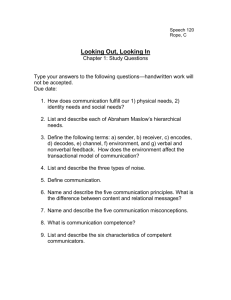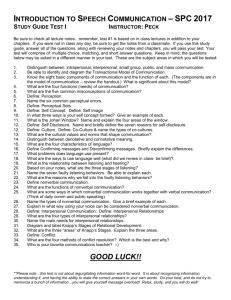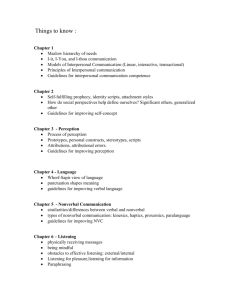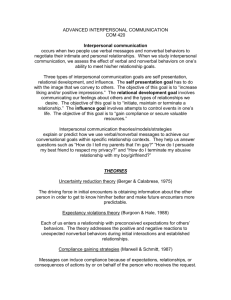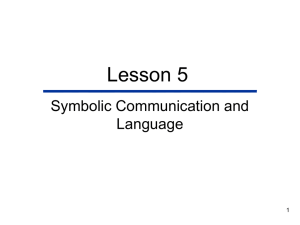Nonverbal + Interpersonal Communication
advertisement
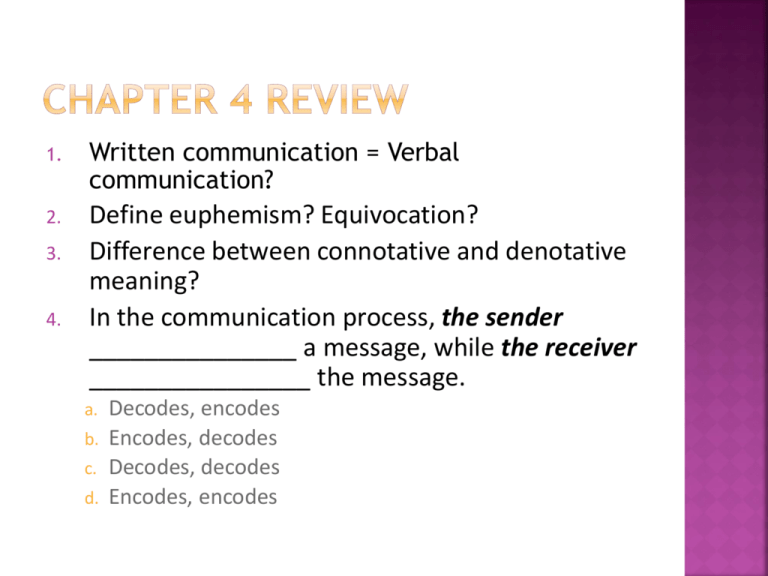
1. Written communication = Verbal communication? 2. Define euphemism? Equivocation? Difference between connotative and denotative meaning? In the communication process, the sender _______________ a message, while the receiver ________________ the message. 3. 4. Decodes, encodes b. Encodes, decodes c. Decodes, decodes d. Encodes, encodes a. Consider the role of verbal communication: How difficult would it be to have interpersonal communication without using verbal communication? Let’s play our version of CHARADES and see! Chapter 5 Recap/Lecture One cannot avoid communication Communication transactional = Communicating without words Plays role in communicating effectively Helps with conversation management Intentional and unintentional Consciously and unconsciously (largely the latter) Shared meaning Often ambiguous More believable than verbal communication May conflict with verbal communication Mixed messages Can be used to regulate and adapt to conversation Interaction adaption theory (for the latter) Culture Gender Age Context Visual-Auditory Contact Codes Codes Place and Time Codes Body Movement (Kinesics) Body Orientation Gestures Delivery Citing Seeking Turn http://www.youtube.com/watch?v=iA3QNM5eKNw Physical Appearance Physical Characteristics Level of attractiveness Body artifacts (e.g. jewelry, tattoos, body piercings) Examples Consider you interacting with this person (so interpersonal communication) Think about your willingness to …date …interview …work with on a project …hang out with ….trust …approach Facial Communication Eye Contact Facial Expressions Smiling Voice (Paralanguage) – How you say it Vocal qualities Vocal distractors “ums”, “uhs”, “ehs” Vocal characterizers Pitch, rate, volume, tempo, pronunciation, etc Crying, laughing, whining, muttering, etc. Silence http://www.youtube.com/watch?v=jI4OCSYXPHM Touch = Haptics Functions of touch Positive Playful Control Ritualistic Task Hybrid Accidental Space Personal space How do we protect our personal space? Territoriality/Territorial Markers Distance = Proxemics Personal, intimate, social, or public How do we respond if our space is violated? Expectancy Violation Theory The Environment (e.g. color, lighting, room design) What do these colors usually communicate? Red Black Green Blue Pink Time (Chronemics) Late to your first date? Late to dinner with your best friend? Late to meeting with professor? http://www.youtube.com/watch?v=bh_ _g-ZZ6WA Differences between men and women, in terms of nonverbal communication? Your thoughts? (Application Exercise) http://www.youtube.com/watch?v=GzkykWD0a0 White Chicks What about in different settings? (Focus on INTERPERSONAL communication) Workplace? Church? Dance club? Are dance moves examples of nonverbal communication? What do they communicate in interpersonal communication? Hot Chick (43:07 mark) Understand the relationship between verbal and nonverbal communication Be tentative with your interpretations Avoid nonverbal distractions Remember the role of context in nonverbal communication Pay attention to your own nonverbal behaviors Ask others about your nonverbal communication Before we evaluate your listening within interpersonal communication, let’s continue to evaluate your individual listening skills Practice your listening within two different scenarios; one from category A and one from category B Category A: favorite television show, new/unfamiliar song by favorite artist, favorite talk show, funny/interesting clip on YouTube Category B: news broadcast, political speech, class lecture (other than our class) Compare your listening for each: What were the similarities and/or differences? Were there any barriers involved? (noise, message overload, message complexity, etc.) Were you an effective listener? Why or why not? (use textbook terminology in your explanation) Now, wait until the next day (or at least a few hours); how much of each situation do you still remember? What helped you remember? See assignment sheet for format Second AE – Bring an item that is important to you Quiz
